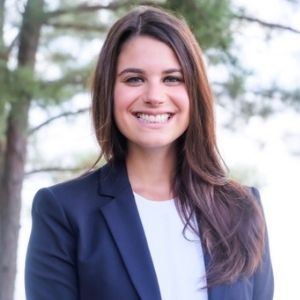Reflections: What I Learned as a Student in the Puller Veterans Benefits Clinic
 Jamie Eisner is currently a third-year law student at William & Mary. In addition to her work with the Puller Clinic, she has interned at the U.S. Office of Special Counsel and at the Virginia Sexual & Domestic Violence Action Alliance. She is the Articles Editor of the William & Mary Journal of Race, Gender and Social Justice, Vice President of the Women's Law Society and recipient of the CALI Excellence for the Future Award (Legal Research & Writing II). She is a summa cum laude graduate of Wake Forest University and a member of Phi Beta Kappa.
Jamie Eisner is currently a third-year law student at William & Mary. In addition to her work with the Puller Clinic, she has interned at the U.S. Office of Special Counsel and at the Virginia Sexual & Domestic Violence Action Alliance. She is the Articles Editor of the William & Mary Journal of Race, Gender and Social Justice, Vice President of the Women's Law Society and recipient of the CALI Excellence for the Future Award (Legal Research & Writing II). She is a summa cum laude graduate of Wake Forest University and a member of Phi Beta Kappa.
Following graduation, she will join the firm of Peer, Gan & Gisler in Washington, D.C.
I joined the Puller Clinic during the Spring of my 2L year in 2020. When I registered, I expected to gain valuable hands-on experience, work directly with clients, and learn about an area of law in which I previously had no knowledge. Of course, I received all of this. However, I also had the rare opportunity to prepare for and litigate my first real case at the Board of Veterans’ Appeals in Washington, D.C.
Unlike most clients, this client was only in the clinic for a few months before her hearing, as she had made her claim for benefits back in 2016. Although she was severely disabled and confined to a wheelchair, with evidence that an incident during active duty military service was the cause, the VA had denied multiple claims for benefits. She was rightfully frustrated with the process, and she came to the clinic with hopes that we could help change the results.
For the majority of cases, it could take years to receive any sort of determination from the VA; however, once we got the notification that the hearing for this client was scheduled, the process moved very quickly. I was assigned this client in mid-January, and the hearing was in early March. Building on the hard work of previous Puller Clinic students Kelsey Reichardt and Ian Hutter, I made a litigation strategy, routinely spoke to the client on the phone to prepare her for questioning, and prepared an opening statement to give in front of the judge.
As a 2L, I had never done anything like this before, so naturally I was very nervous, but Professor Stone was there to guide me every step of the way. During our first one or two calls with the client to discuss the hearing, Professor Stone sat in the room with me to make sure I was on the right track. Then after those first calls, he trusted me enough to speak with the client on my own and report back to him. It was during this period, when I was speaking to the client directly and constantly reviewing the case, that I gained confidence in my ability to successfully help advocate for our client. By early March, I knew the client’s case inside and out.
When it was finally time to drive up to D.C. to do the hearing, I was a little nervous, but mostly excited. I was meeting my client in person for the first time, and I was about to have the experience of speaking in front of a real judge. The hearing room itself was pretty small, and I was lucky to have Professor Stone and my clinic partner, Gabby Vance, in there with me for support. I gave my opening statement, then proceeded to question the client like we had practiced during those many client phone calls. The judge then asked a string of questions to the client, and directed a couple clarifying questions to me and Professor Stone. The entire hearing adjourned in about thirty minutes.
Then we waited…
Finally, just a couple weeks ago, Professor Stone informed me that the Board judge granted our client’s claim, and rated her as permanently and totally disabled. She was also awarded around $200,000 in past-due benefits, with more on the way. Throughout my time in the clinic, I really got to know my client, and was so excited that the work I contributed to her case resulted in such a big win for her and her family. It was an honor to have contributed to this case, and I cannot think of a better clinic experience.
About William & Mary Law School
Legal education in a university setting began at William & Mary in 1779. Now in its third century, America's first law school continues its historic mission of educating citizen lawyers who are prepared both to lead and to serve.